
Oil extended gains above $45 a barrel as U.S. industry data showed crude and gasoline stockpiles declined, easing a glut.
Futures advanced as much as 1.9 percent in New York after rising 1.8 percent in the previous two sessions. Crude inventories fell by 8.13 million barrels last week, the American Petroleum Institute was said to report. If the decline is replicated in government data Wednesday, it will be the biggest decrease since September. Gasoline supplies shrank by 801,000 barrels, the API said.
Oil remains in a bear market amid concern expanding global supply will offset curbs by the Organization of Petroleum Exporting Countries and its partners. The Energy Information Administration cut its estimate for 2018 U.S. production to below 10 million barrels a day, the first time the government agency has lowered its forecast since it started making projections in January.
“The API data shows an aggressive decline in stockpiles and gives some confidence in demand,” said Jonathan Barratt, chief investment officer at Ayers Alliance Securities in Sydney. “The likelihood of prices heading toward $50 to $52 is higher after that set of inventory numbers.”
West Texas Intermediate for August delivery added as much as 85 cents to $45.89 a barrel on the New York Mercantile Exchange, and was at $45.78 at 1 p.m. in Hong Kong. Total volume traded was about 2 percent above the 100-day average. Prices increased 64 cents to $45.04 on Tuesday.
See also: Oil Traders Tailor Bespoke Cargoes in a Crude Supermarket at Sea
Brent for September settlement climbed as much as 77 cents, or 1.6 percent, to $48.29 a barrel on the London-based ICE Futures Europe exchange. Prices rose 64 cents to $47.52 on Tuesday. The global benchmark traded at a premium of $2.26 to September WTI.
An EIA report Wednesday is forecast to show U.S. crude stockpiles dropped by 2.45 million barrels, according to the median of 10 analyst estimates in a Bloomberg survey. Supplies remain more than 100 million barrels above the five-year average.
Oil-market news:
U.S. crude output will average 9.9 million barrels a day next year, the EIA said in its monthly Short-Term Energy Outlook Tuesday. While that’s down from a June estimate of 10.01 million, it’s still a record. Saudi Arabia told OPEC it pumped more than 10 million barrels a day in June, exceeding its production limit agreed under a deal to curb output for the first time.
Recommended for you
